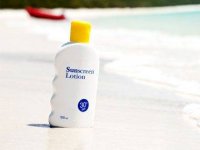J
Jeanh
Guest

Mistake: You only apply sunscreen when you know you'll be outside
“Sunscreen should be part of your daily routine 365 days a year. The number-one mistake I see is people using sunscreen only when they go to the beach or spend time outside,” says Cheryl Gustafson, MD, chief dermatology resident at Emory University and spokesperson for the Skin Cancer Foundation. The sun’s rays can still reach your skin, for example, while you drive or sit by a window. Case in point: A recent University of Washington study found that more than half of cases of melanoma and Merkel cell carcinoma (two deadly types of skin cancer) occurred on the left side of the body—the side more exposed to UV light when driving. (In Australia, where cars drive on the opposite side of the street, research has found skin cancer is more common on the right side of the body).
To get in the habit of applying sunscreen every day, Dr. Gustafson suggests finding a body and facial moisturizer that contains at least SPF 15. Apply it daily after you ******.
 George Clerk/iStock
George Clerk/iStockMistake: You assume applying a high SPF means you can spend more time in the sun
If you coat yourself in SPF 75 or 80, you can safely stay out in the sun longer, right? Um, no. "Some experts believe that higher numbers, such as SPFs 75, 90, and 100, give people a false sense of security," Connecticut dermatologist Mona Gohara, MD, told You do not have permission to view the full content of this post. Log in or register now.. One study published in the International Journal of Cancer found that people who used an SPF 30 spent up to 25 percent longer in the sun than those who slathered on SPF 10, which means a greater risk of sunburn as well as skin damage you can’t see.
Stick to SPF 30 and reapply at least every two hours, or more frequently if you’ve been in the water, says Dr. Gustafson. The Skin Cancer Foundation also recommends a minimum of SPF 30, which blocks 97 percent of UVB rays, and a maximum of SPF 50, which blocks 98 percent of the sun’s UVB rays. “As you get higher and higher, it’s not really a practical difference,” David M. Pariser, MD, past president of the American Academy of Dermatology told the You do not have permission to view the full content of this post. Log in or register now..
 AntonioGuillem/iStock
AntonioGuillem/iStockMistake: You don't use enough sunscreen
If you’re applying enough, you should restock your sunscreen supply several times each summer. A golf ball-sized squirt is the perfect amount of sunscreen to cover your entire body, says Dr. Gustafson. That translates to using between one-quarter to one-half of an eight-ounce bottle—per person—during a long beach day. Research shows most people apply only 25 to 50 percent of the amount of sunscreen used during testing, which means your actual SPF coverage is about one-third of what’s on the label. (In other words, an SPF 30 is only as strong as an SPF 10 if you don’t apply it thoroughly).
 JackJelly/iStock
JackJelly/iStockMistake: You use lotion that's been in your beach bag forever
Check the bottle’s expiration date before you rub on old lotion. Expired sunscreen may not provide proper protection because the chemicals become inactive over time. If there’s no expiration date stamped on the bottle, write the date you bought it on the side and toss it after one year has passed, Debra Jaliman, MD, a dermatologist in New York City, told You do not have permission to view the full content of this post. Log in or register now..
Have a tube stashed in your glove compartment or trunk all summer? Toss it. Heat can cause the active ingredients to break down, rendering them less effective and leaving your skin at risk, according to You do not have permission to view the full content of this post. Log in or register now..
 Jacob Ammentorp Lund/iStock
Jacob Ammentorp Lund/iStockMistake: You only use spray sunscreen
Spray sunscreens might seem convenient, but their potential health risks still haven’t been fully investigated. Safety experts at Consumer Reports are concerned about the effects of accidentally inhaling the spray’s ingredients, particularly on children. They recommend spraying sunscreen into your hand first, then rubbing it on your body.
What’s more, it’s hard to apply spray sunscreen evenly when it’s windy out (which is commonly the case at the beach). Apply more than one coat and rub in well to be safe.
 Nicolas McComber/iStock
Nicolas McComber/iStockMistake: You miss common spots like the ears, scalp, and lips
You need to cover more than your arms, legs, chest, and back with sunscreen. Dr. Gustafson says she often sees patients develop skin cancer on commonly missed areas like the scalp, ear, lips, front and back of neck, backs of hands, and top of the feet. Basal or squamous cell cancers (slow-spreading cancer in the outer layer of skin) most commonly affect these areas because they’re frequently exposed to sun.
Look for lip balms with SPF included and reapply every 90 minutes to two hours, she says. While there are sunscreens specifically for the scalp, you can also use a spray and rub it in.
 gaiamoments/iStock
gaiamoments/iStockMistake: You apply sunscreen after you get to the pool
A better move: Apply it at home before you head outdoors. For one thing, this gives your skin time to absorb the sunscreen, which is necessary for sunscreen to do its job—either deflect or absorb UV light, depending on the type. For another, you’ll be less likely to miss a spot if you take the time to do it at home before you’re rushed and distracted while out and about.
Attachments
-
You do not have permission to view the full content of this post. Log in or register now.